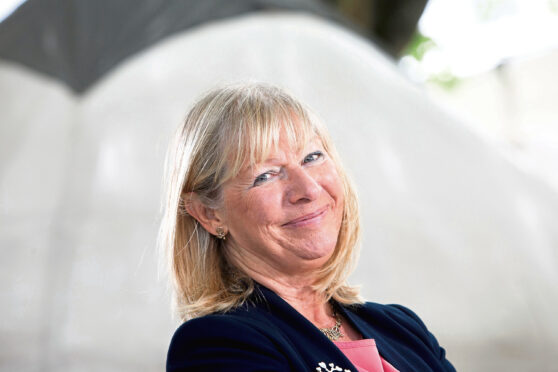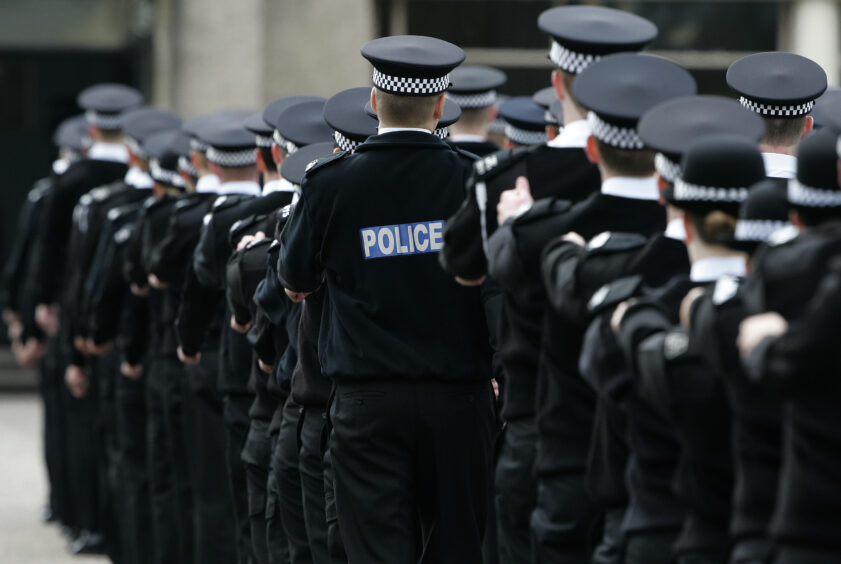
Alex Gray stood, head bowed, hands clasped in prayer, as one of the finest men she knew was laid to rest. The award-winning crime writer and co-founder of the Bloody Scotland crime writing festival owed him a great deal.
The serving police officer she was introduced to as Detective Chief Inspector Ronnie Beattie had been among the first from the force to talk her through the world of policing, lending her debut of more than two decades ago the authenticity that was the springboard to success.
Beattie became part of the inspiration for the much-loved hero in her best-selling Detective William Lorimer series. Now her 20th in the series, Questions For A Dead Man, published last week, is dedicated: “To all the officers of Police Scotland, past and present”. It is also a love letter to her home city of Glasgow. And Gray hopes the book will shine a light on the efforts of a force she says strives to deliver daily on its “duty of care” despite facing some of the greatest challenges the organisation has known, from budget cuts to racism and spiralling drugs deaths.
Gray, who holds the Scottish Association of Writers’ Constable and Pitlochry trophies, told The Sunday Post: “When I was just starting out as a writer in the late ’90s, I knew nothing about the way the police proceeded.
“But I needed to see and talk to real policemen and women and go where they went. So I wrote to the then chief constable at Clyde who sent me to my local police station and they got me an interview with a detective chief inspector in Paisley.
“That is when I met DCI Ronnie Beattie. He gave me a huge amount of help and was a bit of the inspiration for William Lorimer. Just like the character in my books, he was a happily married, family man, bright, tall, dark and handsome and with a huge amount of integrity. He ended up deputy divisional commander at Kilmarnock but he had already been commandant at Tulliallan Police College. He died in his early 50s not long after retiring. It was a huge funeral, I was there, at Eaglesham. It was very sad.”
Gray’s connection with the force continued, however. “A number of years ago I went to Gartcosh (the Scottish Crime Campus) and took with me my crime-writing friends Chris Brookmyre, Ian Rankin and Lin Anderson. The four of us were shown around. One of the senior officers was the now Chief Constable Sir Iain Livingstone.
“He took me aside and said: ‘We want to give you as much information as possible so you can put it in your books and the public will read it.’ He considered it would help the public understand the work of the force. I’ve since had access to Tulliallan and training facilities at Jackton in East Kilbride as well as the Police Treatment Centre at Castle Brae in Auchterarder.”
Her visits to Tulliallan and Jackton were crucial to the latest novel in which she writes in-depth for the first time about the work of uniformed offers. She needed to see first-hand what their training involved, feel the physical weight of their equipment and witness a passing-out parade. She explained: “My dear late friend, author Alanna Knight, always said: ‘You have to walk the path and touch the stones.’ That was her motto. I believe it is true.”
She took the steps walked by her fictional new uniformed recruit Daniel Kohi, a black Zimbabwean detective who fled persecution from corrupt officers in his homeland following the murder of his wife and child and who readers meet in the opening chapter at Tulliallan during his passing-out parade. It was an opportunity to explore racism in the force.
Gray – who lived in Zimbabwe for a spell after marrying her husband Donnie in the country in 1976 when he went there to work as an accountant – said: “The best police officers are heroes in my books, although I always have the not-very-nice cop. There are always going to be bad apples in a big barrel like a police institution.
“I thought it was realistic to show a wee bit of racism Daniel encountered at Tulliallan and in the police station in Govanhill. These incidents are fictional but we know they do happen. There is an element of racism among the police and we want it to be completely eradicated.”
Even the well-meaning can be unwittingly racist she points out, highlighting a nurse in the novel who is initially condescending towards the young black officer until she realises he is a cop. But overall, she says, the racism he encounters is tempered by the warmth of the welcome he receives in Glasgow, a city of inclusivity where he finds the friendship of Lorimer, the devotion of an elderly neighbour and a love interest in a courageous female officer.
In the novel, Gray tackles drug addiction, the deaths that ensue, and drug-fuelled gangland crime. As her protagonist Lorimer looks at reports of the latest drugs death in Govanhill, Kohi’s beat, Gray flags the drugs strategy launched at the start of 2020 – based on factual research – and “Greater Glasgow’s shame” that “they’d had the highest number of drug-related deaths in the country for the previous five years, and despite their best efforts drugs were still pouring into the city.”
There’s a poke too at government tightening purse strings – the fictitious first female chief constable, an Englishwoman, being told to cut millions from the police budget, with already “not enough” officers to deliver on their pledged “duty of care” to every citizen without exception; even the criminals.
“The police feel that they don’t have enough personnel and resources,” said Gray. “If you spread things too thinly, you are not going to make a difference. The police are always asked to do far more than they are able to do. In the book, Daniel picks up a dead drug addict, this happens. I am writing book 21 now and in it he finds a homeless man in freezing conditions and takes him to A&E. These things happen.
“If you go into Glasgow any time you are bound to see homeless people and people ravaged with addictions. It is dreadful, so sad, so unnecessary, and a scourge on Western society. One of the evils of life is that the evil prey on the weak. It has been like that forever and it is one of the terrible flaws of humanity. And the police have to deal with that. They have to pick up the pieces.
“I wouldn’t go into Glasgow late at night on my own, but if you went with a police officer, they know what happens, and where to look for these people, and they take care of them. The thing I wanted to emphasise was a duty of care, because duty of care is drummed into the police from training, right through the ranks.”
Gray’s book was completed before the Scottish Government announced its policing budget of £1.45 billion for 2023/24. Livingstone welcomed it as an improvement but warned “hard choices” still lay ahead and on Thursday announced he will retire in the summer.
Ultimately, Gray would like to see more resources made available to police and to prisoner and drug rehabilitation. The mum and grandmother, a committed Christian, said: “I wanted to show in the book that redemption is possible. Things aren’t black and white, there are so many shades of grey in life. If money could go into the rehabilitation of offenders, how much better would things be?
“I remember going into Cornton Vale women’s prison in Stirling for research. I was impressed with what they were doing to help women get back into work after release. When offenders leave prison, they have paid their price and done their time and they have to be seen as able to rejoin society and have a fresh start. People think that once a prisoner, always a bad person. And that is not true. The first thing a prison officer told me was: ‘Don’t think of this as a place full of bad people. It is a place full of people who have made bad choices.’
“We can all make mistakes and some people make extremely awful mistakes that land them in prison but we all have to learn to forgive.”

Enjoy the convenience of having The Sunday Post delivered as a digital ePaper straight to your smartphone, tablet or computer.
Subscribe for only £5.49 a month and enjoy all the benefits of the printed paper as a digital replica.
Subscribe © PA Archive/Press Association Images
© PA Archive/Press Association Images